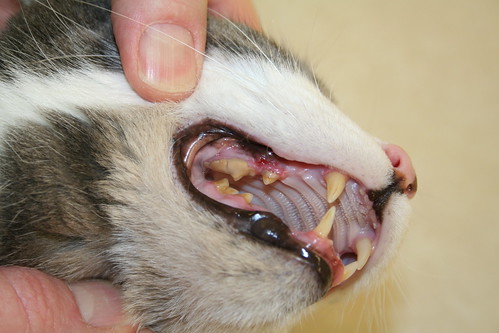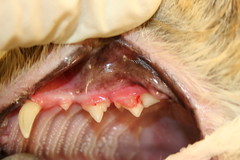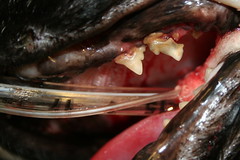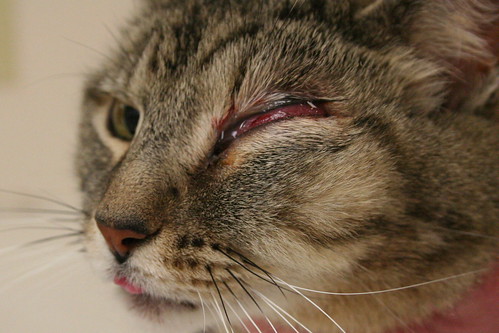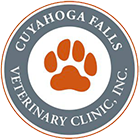Why is it important to examine a cat at least once per year? Because cats are fantastic at hiding illnesses and abnormalities. One area that can cause pain and discomfort for cats is the mouth. Cats don’t brush their teeth every day, so dental tartar build-up is very common. The bacteria that lives on dental tartar, if not treated, causes gingivitis and periodontal disease. Further, some cats develop disease of their teeth called Feline Resorptive Lesions (FRLs), which are quite painful.
|
But even as dental tartar accumulates and gingivitis leads to periodontal disease, and even as FRLs emerge and damage particular teeth, cats will continue to eat and will still try to act as normal as they possibly can. That’s why it is incumbant upon us as pet owners to make sure our feline friends don’t have to hide sickness.
When it comes to cats’ mouths, dental disease can get ugly. Dental tartar can be minor… or major. An average mouth that has not seen dental care in a couple of years is depicted here on the right.
FRLs, erosive lesions of the tooth’s enamel that expose the sensitive tissue within the tooth, are painful and should not be ignored. These can be tricky to find sometimes. Often the gum tissue will grow over the lesion in an attempt to protect the space. When FRL’s are on the surface of the crown, they can be found by our doctors on physical examination. Sometimes FRLs are beneath the gum line and require probing and dental radiography to find.
|
(In the series of four photos to the left, the top photo shows a molar on the right-hand side with an FRL that is covered with gingiva. The second photo shows a tooth that has literally had a root resorbed away [ouch!]. The third photo demonstrates the inflammation and swelling that can occur with a tooth root abscess secondary to FRLs. The FRL in the photo on the bottom is marked.)
Treatment for dental tartar accumulation is a thorough scaling and polishing of the teeth. This can only be done with the help of general anesthesia, as no cat will hold still for the process. (Also, we must protect an animal’s airway during a dental cleaning procedure.) Scaling the dental tartar that is seen is important. Perhaps more importanly, though, is the cleaning of the 1- to 2-millimeter space under the gum line, which is crucial to the health of the mouth. If this space is not cleaned, the bacteria that lives there can break down the barrier between the gum and the underlying bone. This is the beginning of periodontal disease.
Scraping dental tartar alone, as is done by those who claim to clean an animal’s teeth without the aid of general anesthesia, leaves scratches on the teeth that are fantastic surfaces for bacteria to lodge after the scraping. This simply sets up the mouth for dental disease to progress more rapidly than before. Polishing the teeth is a vital step that smoothes the surface of each tooth.
When FRLs are present, extraction isn’t just the best option, it is the only option. Feline Resorptive Lesions are painful and progressive. The damage and pain must be limited by removing the diseased teeth.
Paying attention to the subtleties of cats’ health is important to their quality of life. It is when the little things are ignored that they can turn into big things. Disease is often easier to manage and potentially cure when it is detected early. So when it comes to your cat’s overall health, and particularly the health of the mouth, be proactive! An ounce of prevention is worth a pound of cure, a wise man once said. While we can help with the cure, we’d rather take the side of prevention with you and your kitty. If you have any questions about your cat’s health, oral or otherwise, give us a call at 330-929-3223 to set up an appointment.

